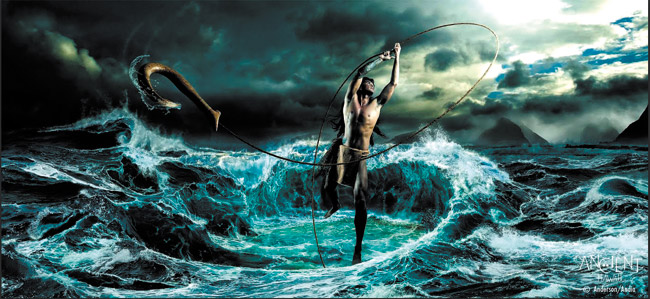Ancestral Invocation

‘The Catch — Ho‘ohopu’ by Colin Anderson is inspired by legends of demigod Maui, represented here with his mighty hook, attempting to capture the Islands and bring them closer together.
PHOTO COURTESY OF ANDERSON ANDIA.
Pele dances, a train of molten lava blazing in her wake. Hawaiian war god Ku flexes his chest in haka stance, his mouth fixed in a permanent war cry. These are images so culturally familiar, yet they’ve never been presented with the immediacy of Colin Anderson and Robert Andia’s collaboration Ancient Hawaii, on exhibit at Honolulu Museum of Art School. Anderson’s masterful photographic art makes use of Hawaiian scene-scapes and live Hawaiian models to portray Hawaii’s ancestral gods.
Both photographers, Hawaii’s Andia met Australia’s Anderson four years ago, when the latter was here shooting a project of his own. Andia had dreamed since childhood of creating artistic representations of prominent figures in Hawaii’s traditional legends. He even had 30 or so sketches of pig god Kamapua‘a, demigod Maui, god of the oceans Kanaloa and many more to show Anderson.
“The stories lend themselves beautifully to graphic visual,” says Anderson, who was instantly taken with the renderings. The two settled on 15 of their favorite legends and Andia got to work finding models. Eager for authenticity, the men chose Hawaiian models and relied on knowledge and props from Hawaiian cultural advisers. Shooting the models took two weeks, and shooting background elements took another few weeks. Back in Australia, Anderson combined hundreds of layers to create each image and digitally manipulated them in Photoshop and 3-D. Some fell together beautifully, while others proved challenging.
“To create the final images took me six months of 18-hour days, seven days a week,” he notes.
He’d start his days at 3 a.m. and work straight into the night. There were rough moments where, for instance, he realized that Hi‘iaka’s detailed skirt he’d been working on for five days was made of the wrong kind of foliage and he had to restart from scratch. Appropriately, his first image of Wakea (Earth Mother) and Papahanaumoku (Sky Father), the original ancestors, turned out to be an easy piece. He finished with warrior Ku, the most time-consuming work, as it depicts a full battlefield of men.
“We had more than 700 shots of (model) Pomai Brown as Ku,” says Anderson. “We had a Hawaiian ancient weapons expert La‘akea Suganuma, who provided us with the weapons and showed us how to use them. His knowledge was phenomenal. Technically, we had to have everything correct, as in what weapons would be used and where.
“I cut out each image of Pomai ― 130 individual shots in Photoshop ― and placed them into the background. Just getting the perspective right is a process that took planning in advance of the shoot. We shot every weapon three ways and from several different height levels, as well, to ensure we got all the perspectives right, because until you build the background, you’re not sure what height you need to shoot from. It was easily the most work l have ever done on one image.”
Anderson’s magnificent rendering of Pele is a doozy — she’s so well-known, he felt compelled to meet expectations with a powerful image. When you see Pele on tiptoe, her skirts realistically aflame, you’ll agree that he succeeded. (See all 15 exhibit images at hawaiiancient.com.) A challenge of another sort was presented in finding the right live pig for the Kamapua‘a image.
“It took Robert months to track down the perfect pig and shoot it ― photographically ― and send it to me,” notes Anderson.
Attention to detail is what makes the images really stand out, whether it meant shooting a model for hours to get just the right pose, or painstakingly hand-painting veins of lava into every crevasse of Pele’s volcanic dress. One shot even managed to include the Hokule‘a in the background. Two images of Kanaloa capture his fierce and calm natures, with the calm image featuring the celebrated voyaging vessel.
“It took some organizing,” points out Anderson, “but Bob was able to get permission to photograph it.”
Once the Honolulu exhibit concludes, Andia and Bill Wyland of Wy’s Gallery are arranging to take the Anderson Andia project on the road from L.A. to New York, Japan and beyond, to promote Hawaiian culture.
“Ancient’s goal to generate awareness of the beauty and culture of the Hawaiian Islands, and of its indigenous people, and their legends and ancestors motivated me to be part of this unique project,” says Wyland. “I look forward to bringing Hawaii’s beautiful settings and cultural and environmental themes of Anderson Andia’s cutting-edge imaging technologies to locations on the Mainland and throughout the world.”
Wyland also points out that a percentage of profits generated by Ancient are being given to Hawaiian educational and cultural organizations. The public is invited to the opening night reception April 2, from 5 to 9 p.m., with drinks, pupu and 5:30 p.m. entertainment by Makana, who also weighed in on the exhibit
“Reinterpreting culture through a modern lens, when done with respect and sensitivity, is vital to maintaining its relevance in contemporary society, and Ancient Hawaii has done just this,” he says. “The collection breathes new ha into the legendary figures of Hawaiian lore, reanimating their surroundings in a fantastic way that ignites a newfound perception of the past.”
Ancient is sharing its opening night festivities with Contact, an exhibit on the lower floor of the art school. The juried show is themed to reflect a later period of historical contact for Native Hawaiians, from the 1890s through the 1930s, a time of upheaval and loss of self-governance. Contact is a 10-day pop-up exhibit, running through April 12.
Together, the two shows present diverse and complementary commentary on Hawaiian history.
the TICKET stub
ANCIENT HAWAII
When: April 2-30
Where: Honolulu Museum of Art School, Linekona Building
More Info: hawaiiancient.com





